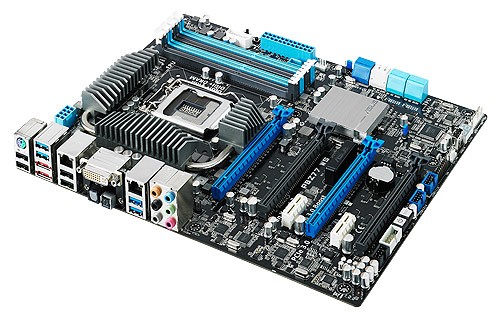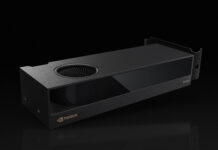Hot on the heels of the Z9PE-D8 WS first view that Patrick will have a review of shortly, today we are doing a first look of the ASUS P8Z77 WS (which Patrick will also be reviewing soon.) The ASUS P8Z77 WS board is for the more mainstream desktop LGA 1155 based Ivy Bridge and Sandy Bridge CPU’s. This does of course mean it has its limitations such as PCIe lanes available to the platform as compared to the ASUS P9X79 WS reviewed recently, but ASUS does what it can to alleviate these. This is a preview before the official STH review. With its angular heatsinks, it looks industrial just like the P8P67 WS Revolution reviewed here last year, but let’s look at the specs of the new version:
Specifications
| CPU | Intel® Socket 1155 for 3rd(Ivy Bridge) /2nd (Sandy Bridge) Generation Processors Supports Intel® 22 nm CPU Supports Intel® 32 nm CPU Supports Intel® Turbo Boost Technology 2.0 * The Intel® Turbo Boost Technology 2.0 support depends on the CPU types. * Refer to www.asus.com for CPU support list |
| Chipset | Intel® Z77 |
| Memory | 4 x DIMM, Max. 32GB, DDR3 2800(O.C.)/2600(O.C.)/2400(O.C.)/2200(O.C.)/2133(O.C.)/2000(O.C.)/1866(O.C.)/1800(O.C.)/1600/1333 MHz Non-ECC, Un-buffered Memory Dual Channel Memory Architecture Supports Intel® Extreme Memory Profile (XMP) * Hyper DIMM support is subject to the physical characteristics of individual CPUs. * Refer to www.asus.com or user manual for the Memory QVL (Qualified Vendors Lists). |
| Graphic | Integrated Graphics Processor VGA output support : DVI port – Supports DVI with max. resolution 1920 x 1200 @ 60 Hz Supports Intel® HD Graphics, InTru™ 3D, Quick Sync Video, Clear Video HD Technology, Insider™ |
| Multi-GPU Support | Supports NVIDIA® 4-Way SLI™ Technology Supports AMD Quad-GPU CrossFireX™ Technology Supports LucidLogix® Virtu™ MVP Technology *1 |
| Expansion Slots | 4 x PCIe 3.0/2.0 x16 (dual x16 or x16, x8, x8 or quad x8) *2 2 x PCIe 2.0 x1 |
| Storage | Intel® Z77 chipset : 2 x SATA III 6Gb/s port(s), white 4 x SATA II 3Gb/s port(s), blue Support Raid 0, 1, 5, 10 Supports Intel® Smart Response Technology, Intel® Rapid Start Technology, Intel® Smart Connect Technology *3 Marvell® PCIe 9128 controller : 2 x SATA III 6Gb/s port(s), navy blue Support Raid 0, 1 ASMedia® PCIe SATA controller : *4 2 x eSATA III 6Gb/s port(s), red |
| LAN | Intel® 82574L, 2 x Gigabit LAN Controller(s) |
| Audio | Realtek® ALC898 8-Channel High Definition Audio CODEC – Supports : Jack-detection, Multi-streaming, Front Panel Jack-retasking Audio Feature : – Absolute Pitch 192kHz/ 24-bit True BD Lossless Sound – Blu-ray audio layer Content Protection – DTS Ultra PC II – DTS Connect – Optical S/PDIF out port(s) at back panel |
| USB Ports | ASMedia® USB 3.0 controller : *5 2 x USB 3.0 port(s) (2 at back panel, blue) Intel® Z77 chipset : *5 4 x USB 3.0 port(s) (2 at back panel, blue, 2 at mid-board) Intel® Z77 chipset : 9 x USB 2.0 port(s) (4 at back panel, , 5 at mid-board) |
| Workstation Feature | 4 x PCIe x 16 slot(s) Quick Gate: 1 x vertical USB 2.0 on board ASUS SASsaby series Cards support ASUS WS Diag. LED ASUS WS 3-color LED |
| Special Features | ASUS Dual Intelligent Processors 3 – SMART DIGI+ Power Control : SMART DIGI+ : – Smart DIGI+ Key- quickly delivers higher VRM frequency, voltage and current for superior CPU/iGPU/DRAM overclocking performance with one switch. – Smart CPU Power Level (Intel® VRD 12.5 Future Power Design)- provides the best digital power saving conditions. ASUS Hybrid Processor – TPU : – Auto Tuning – TurboV – TPU switch ASUS EPU : – EPU – EPU switch ASUS Digital Power Design : – Industry leading Digital 20 Phase Power Design (16 -phase for CPU, 4 -phase for iGPU) – Industry leading Digital 2 Phase DRAM Power Design – CPU Power Utility – DRAM Power Utility ASUS Exclusive Features : – USB BIOS Flashback – MemOK! – AI Suite II – Ai Charger+ – USB Charger+ – Anti-Surge – ASUS UEFI BIOS EZ Mode featuring friendly graphics user interface – ASUS SSD Caching – Network iControl – USB 3.0 Boost – Disk Unlocker ASUS Quiet Thermal Solution : – Stylish Fanless Design Heat-pipe solution – ASUS Fan Xpert 2 ASUS EZ DIY : – ASUS O.C. Tuner – ASUS CrashFree BIOS 3 – ASUS EZ Flash 2 ASUS Q-Design : – ASUS Q-Code – ASUS Q-LED (CPU, DRAM, VGA, Boot Device LED) – ASUS Q-Slot – ASUS Q-DIMM – ASUS Q-Connector |
| Back I/O Ports | 1 x PS/2 keyboard/mouse combo port(s) 1 x DVI-I 2 x eSATA 6Gb/s 2 x LAN (RJ45) port(s) 4 x USB 3.0 4 x USB 2.0 1 x Optical S/PDIF out 6 x Audio jack(s) 1 x USB BIOS Flashback Button(s) |
| Internal I/O Ports | 1 x USB 3.0 connector(s) support(s) additional 2 USB 3.0 port(s) (19-pin) 2 x USB 2.0 connector(s) support(s) additional 4 USB 2.0 port(s) 1 x Vertical USB 2.0 port(s) 4 x SATA 6Gb/s connector(s) 4 x SATA 3Gb/s connector(s) 1 x CPU Fan connector(s) (4 -pin) 4 x Chassis Fan connector(s) (4 -pin) 1 x Optional Fan connector(s) (4 -pin) 1 x S/PDIF out header(s) 1 x 24-pin EATX Power connector(s) 1 x 8-pin ATX 12V Power connector(s) 1 x 4-pin EZ_PLUG Power connector(s) 1 x Front panel audio connector(s) (AAFP) 1 x System panel(s) (Q-Connector) 1 x MemOK! button(s) 1 x TPU switch(es) 1 x EPU switch(es) 1 x Power-on button(s) 1 x Reset button(s) 1 x Clear CMOS jumper(s) |
| Accessories | User’s manual I/O Shield 2 x SATA 3Gb/s cable(s) 4 x SATA 6Gb/s cable(s) 1 x 3-Way SLI bridge(s) 1 x 4-Way SLI bridge(s) 1 x SLI bridge(s) 1 x Q-connector(s) (2 in 1) |
| BIOS | 64 Mb Flash ROM, UEFI AMI BIOS, PnP, DMI2.0, WfM2.0, SM BIOS 2.5, ACPI 2.0a, Multi-language BIOS, ASUS EZ Flash 2, ASUS CrashFree BIOS 3, F12 PrintScreen, F3 Shortcut Function and ASUS DRAM SPD (Serial Presence Detect) memory information |
| Manageability | WfM 2.0, DMI 2.0, WOL by PME, PXE |
| Support Disc | Drivers ASUS Utilities ASUS Update Anti-virus software (OEM version) |
| Form Factor | ATX Form Factor 12 inch x 9.6 inch ( 30.5 cm x 24.4 cm ) |
| Note | *1: LucidLogix Virtu MVP supports Windows 7 operating systems. *2: PCIe 3.0 speed is supported by Intel® 3rd generation Core™ processors. *3: Supports on Intel® Core™ processor family with Windows 7 operating systems. *4: These SATA ports are for data hard drivers only. ATAPI devices are not supported. *5-1: Supports ASUS USB 3.0 Boost UASP Mode. *5-2: The USB 3.0 ports only support Windows® 7 or later versions. *6: Due to Intel® chipset limitation, P8Z77, P8H77 and P8B75 series motherboards do not support Windows® Vista operating system. |
As we have come to love from ASUS WS line, this board is packed with all sorts of goodies. First being the new Z77 chipset, allowing for the new 22nm Ivy Bridge CPU’s, good for lower powered computers and the ability to use things such as PCIe 3.0 and video output from the motherboard. As for RAM, 32GB is fine for most workstation users looking at LGA 1155 CPUs. Heavy power users will likely still prefer a X79 solution and Sandy Bridge-E CPUs.

For the expansion slots, The P8Z77 WS has four PCIe 3.0 x16 slots which allow for dual x16 + x16, x8 + x8 or quad x8 ports (when used with Ivy Bridge CPUs.) When used with Sandy Bridge generation CPUs these will still be PCIe 2.0 slots. This means Quad SLi (but in 8x mode) is possible, making this a good gaming, CAD, or movie editor machine. I should also point out that PCIe 3.0 x8 has roughly the usable bandwidth of PCIe 2.0 x16 so long as the card is also PCIe 3.0 capable.
Now the SATA ports are a mixed bag of controllers. The Intel Z77 controller has two SATA III ports and four SATA II ports standard. ASUS adds the Marvell 9128 with it’s dual SATA III ports, and the ASMedia 2x eSATA III ports. For most of its Z77 lineup ASUS has turned to the ASMedia controller. It would be really cool if ASUS could add a LSI SAS 2008 or better controller onboard and provide a really high-quality onboard solution, but that would make the board really expensive and there are inexpensive options like the IBM M1015 out there. Giving six SATA III ports over 3 controllers, will limit how big RAID arrays can get. Most users will not find this an issue but power users will use an add-in controller to handle the drives.
Six USB3.0 ports (4 at back 2 via connector to the front) is a good start and there are nine more USB 2.0 ports for slower devices. Then there are a tonne of feature that ASUS pack on all their boards, something for everyone, certainly can’t fault ASUS here.
Being an ASUS board it should Overclock very well, this could be the boards saving grace. Over all first thoughts, a good board for part time Workstation needs, or someone that needs better performance than a typical desktop motherboard. Gamers on a budget needing Quad SLi would do well with this board, it will be a heap cheaper than a LGA 2011 solution and it provides decent onboard video. The back panel is packed with expansion ports. For heavy power users, single or dual LGA 2011 based motherboards may be a better option than an Ivy Bridge solution, but the Z77 chipset provides a lot of things you cannot get even on the dual LGA 2011 platform and with much lower power consumption.
At the end of the day, Patrick needs to do his formal review of this board after putting it through its paces. More to come on this board.



